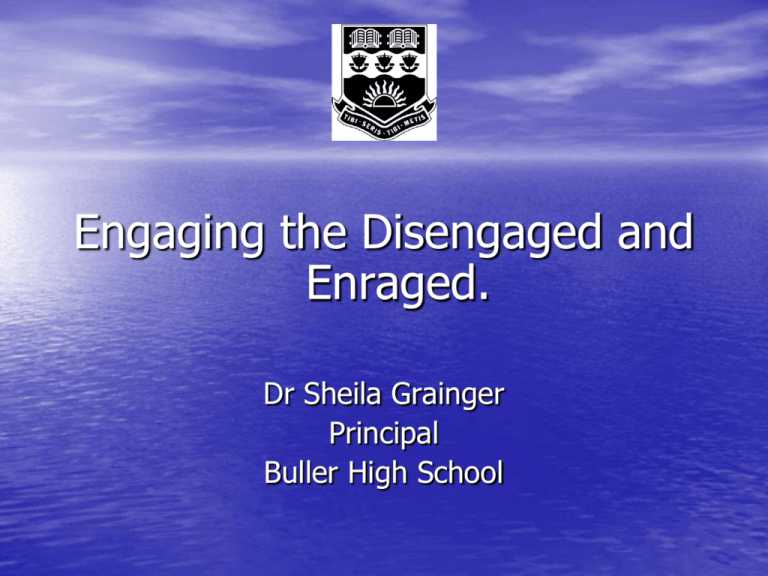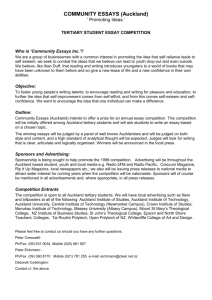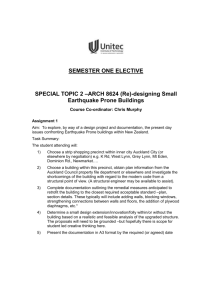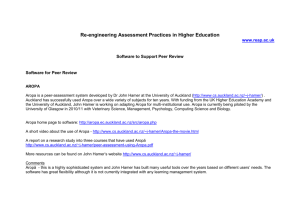Engaging the Disengaged & Enraged PowerPoint
advertisement

Engaging the Disengaged and Enraged. Dr Sheila Grainger Principal Buller High School BHS has an excellent record in preparing engaged and motivated students for future careers or further study However junior students present ever increasing challenges for BHS and at risk students in years 9-10 are a key focus area BHS Year 9-10 Statistics 2008 • 62% of 2008 year 9 students wish they weren’t in school • • • • at all compared with 51% nationally 60% of 2008 year 9 students expect to stay on at school after year 11 compared with 73% nationally 23% of 2008 year 9 students have used drugs once or occasionally compared with 8% nationally 50 suspensions and stand downs in 2008, 43 for year 910 students, predominantly for substance abuse or assault Time out and referral rates for 2008, although decreasing steadily, are still quite high with 575 junior students timed out in terms 1-2 alone • All 8 places at our Alternative Education Programme are • • • • full with a waiting list in place 2 students granted exemptions so far this year, 2 more requested 5 students from years 9-10 on extended work programmes under Section 71 of the Education Act Successive ERO reports highlight the need for greater engagement and enhanced teaching and learning in the junior school The Senior Management Team quality work review has found year 9-10 students take little pride in their work Local environmental factors which impact on student engagement and achievement. • Westport is an area where low skilled employment is readily • • • available so youths leave school without completing qualifications and with no long term plan for sustainable career development Leavers in paid employment socialise with junior students, mainly girls, offering easy access to alcohol, drugs and sex which impact on their engagement with school and their ability to learn Out of school social activities give rise to stormy relationships, verbal and physical altercations, attempted substance abuse etc in school time so that many students’ learning can be disrupted by the disengagement of a few Students’ low self expectations translate into low school pride, 48% of 2008 year 9 students would recommend their school compared with 60% nationally Disengagement • • • • Lateness Continual disobedience Verbal abuse of teachers Lack of career expectations or knowledge Enragement • • • • Physical assault Alcohol Drugs Self harm Sources of Variance in Student Achievement Students 50% Schools 5-10% Peers 5-10% Home 5-10% Principals Included in School Effect Teachers 30% Hattie, J. A. (2003) Making the most of the 30% Expert teachers can be distinguished by 5 dimensions and 16 attributes: • Identifying essential representations of about teaching and learning • Guiding learning through classroom interactions • Monitoring learning and providing feedback • Attending to affective attributes • Influencing student outcomes Attributes • • • • • • • • • • • • Adopt a problem solving stance Can anticipate, plan and improvise Can make better decisions Enhance surface and deep learning Can relate lesson content to other subjects Can be more responsive to students Can recognise events in the classroom impacting on teaching and learning Effective scanners of classrooms Provide relevant feedback Engage students in learning Provide challenging tasks Passionate about teaching and learning BHS Strategies • • • • • • • • • • • Responsibility on enrolment Swim between the flags Support teaching staff Stand downs and suspensions Reintegration School pride School relationships Best we can be Pathways and Futures Department Innovative Project for Students at Risk Understanding the teen brain Allan Wilson Curriculum Alignment Manager Innovative Pathways from School: Taking the first step: Final Report (2006) • A brief look at some models that are working in schools • Collaborations that are working • Schools Plus (Youth Guarantee) A brief history Change • • • • • • Move from Industrial era to Knowledge society. Continual up-skilling On the job training Much greater choice and flexibility Education changed to, “up-skilling the workforce” Increase in courses by tertiary education providers A brief history Policy • Youth Transition Strategy (2002) • 10 - 15 % aged 15 – 19 may not be participating in employment, education or training (Min of Social Development, 2003) • Budget 2003 “..to have all 15-19 year olds engaged in • appropriate education, training, work or other activities leading to long term economic independence…by 2007” “Yeah Right” • 2008 Schools Plus Five strategies At School • STAR - Min of Ed • Gateway - TEC At School or After School • Youth Training - TEC • Training opportunities - TEC • Modern Apprenticeships - TEC Some examples of what has and is working Linwood College - Christchurch Aranui High School - Christchurch Tongariro High School - Taurangi Western Heights High School - Rotorua Aorere College - Auckland James Cook High School – Auckland Auckland Girls Grammar - Auckland Methodology - Early 2002 Phase 1 Description of programme Interviews with programme leader Interviews with students Collating student qualifications and attendance to date. Interviews with non-school providers Interviews with parents/caregivers Collaborations “..Connections of this type are regarded as…. essential for effective transition services” (OECD, 2000) Linwood College – CPIT & TPP Aranui High School – CPIT & TPP Tongariro High School - OPC & BOP Western Heights High School – PTE & Waiariki Aorere College - MIT James Cook High School – Auckland Auckland Girls Grammar – AUT & MIT Strategies developed by schools and tertiary providers 1. Curriculum Alignment project Polytechnics looking at school’s curricula 2. STAR Schools purchase foundation programmes from tertiary providers 3. Gateway Polytechnics used to assess and as brokers 4. Staircasing to higher level qualifications Students encouraged to move on to level 3, 4 and diploma programmes Methodology – End 2002 Phase two Same process as phase one. + • • • • • • What students had gained Students attitudes towards school How prepared were they to leave school Consideration of further training Career aspirations and how programme had helped Student’s sources of career and transition support NB: 02 introduction of NCEA & teachers strike Methodology - Mid 2004 Phase three Approximately one year after most students had left school Interviewed on: Work and study activities Future plans Reflection on how career and transition support was provided Programmes See hand-out (pg 16) Linwood – Advanced Studies Academy Services Academy Urban Music Academy Engineering Programme Art Academy Nat Cert in Tourism Dip ICT Language & Maths Programme Developed relationship with TPP Aranui High School • Developed twelve academies to meet the growing number of students leaving school without jobs or plans. • Aim to keep students at school and provide content related to their interests. • Developed relationship with CPIT and TPP • Students spend 12 hours per week in one of the academy programmes and 12 hours in traditional or alternative classes Aorere College • Tertiary pathways programme • Most senior students not going on to university yet most senior courses offered were at bursary level • Three pathways programmes with MIT. Materials technology, hospitality and catering, and sport and recreation. Results Student perception of preparedness % Very Well Quite well Well Not well Not at all Start 02 19 26 28 23 4 End 02 35 43 16 5 0 Mid 04 28 34 26 11 2 Results Parents perception of preparedness % Very Well Quite well Well Not well Not at all Start 02 18 16 34 25 End 02 49 34 9 1 2 0 N/A 5 6 Student motivation How motivated do you feel by school? A lot Quite a bit A Bit Not much Not at all Start 02 22 28 20 24 5 End 02 41 29 18 - 3 Results Mid 04 Range of activities in Mid 2004 Working Apprenticeships Studying Work/study Non paid work ACC/WINZ benefit 41% 10% 13% 20% 5% 11% Key messages • • • • • • • • Not just having qualifications Having access to advice about careers Developing core skills Having the opportunity to develop and increase self-knowledge and social skills Feeling successful Access to practical skills in their area of interest. Support and encouragement from teachers Access to tertiary education Key messages • Positive attitudes towards school • Relationships with teachers • Access to careers and transition information, • • • • advice and support Real experiences in the world of work Opportunities to gain qualifications Opportunities to develop life skills. Bridges to tertiary environment SCHOOLS PLUS Compulsory training for 16 to 18 year olds Schools Plus Justification • “around 35 percent [of 17-year-olds] leave with less than level 2 NCEA” • “New Zealand’s 15 to 19-year-olds have low participation in education compared to other OECD countries” • “Census 2006 shows that around 10,000 15 to 17-year-olds are estimated to be inactive” (Min of Ed 2008) Schools Plus Rules • 2009 school exemptions at 15 years of age abolished (Bill introduced 9 Sept 08) • 2011 education and training age 17 • 2014 education and training age raised to 18 Schools Plus Cost • An additional 15,000 students in education • Cost the government approximately $150 million per year (Nat est $65M) • Funding is $39.7 million over four years. This sum includes “..staffing, capital and operational costs for schools” (Min of Ed 2008) Schools Plus Implications • Schools responsible for tracking students • Education compulsory till 18 years of age • What incentive to study? (Cf UK) • Reluctant learners at polytechnics? • What strategies will polytechnics have to implement? For more information Innovative Pathways from School: Taking the first step Final report 2006 Sally Boyd, with Sue McDowall and Hilary Ferral http://www.nzcer.org.nz/pdfs/15017.pdf Ministry of Education “Schools Plus” http://www.minedu.govt.nz/theMinistry/EducationInitiative s/schoolsPlus.aspx http://www.schoolsplus.govt.nz/discussion-document.pdf






